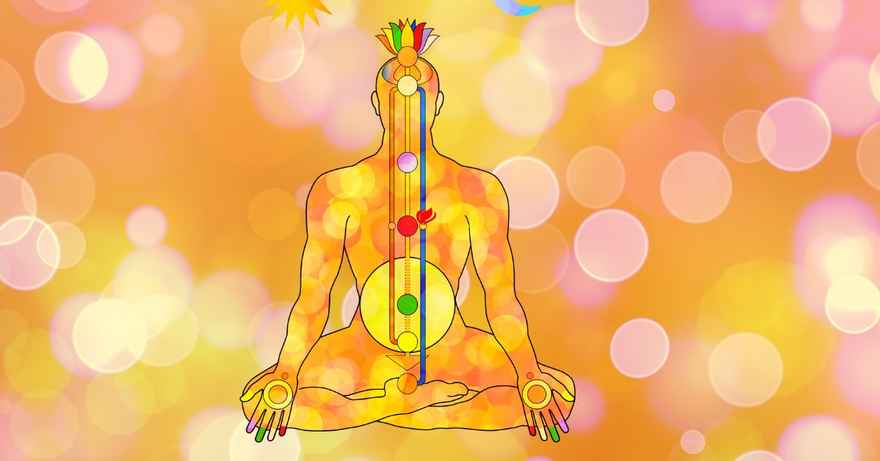Yoga of Mental Health Workshops → More Info
Desires and the Chakras on the Yoga Tantra Path

Desire is a fundamental concern that has occupied spiritual traditions and societies for centuries. What are we to do with these raw energies that have the potential to take us to divine heights and plunge us into the underworld of darkness?
Attempts to deal with desire range from the uninhibited revelry of Greco-Roman cults, the 'desire is good' approach, to the strict asceticism of old-world traditions such as Christianity, Buddhism, and Hinduism, the 'desire is bad' approach. These two approaches still exist today.
For example, The Law of Attraction encourages the pursuit of desires and teaches that whatever you want, believe, and focus on will manifest. On this path, be careful what you wish for. If your desires are not dharmic (aligned with your nature), they may either fail to manifest or cannot bring the satisfaction you imagined.
The ascetic approach aims for a desireless, egoless, and selfless existence. Asceticism views the body and its appetites as separate and inferior to the spirit and prescribes transcendence of the body. To succeed in the ascetic life, the seeker needs a particular temperament, the right environment, conditions, and training.
Who of us can truly give up desire?
Even the intention to surrender desire is a desire.
When desires arise, the ascetic may feel they have failed at spiritual life.
There is a third approach that balances the extremes. More suited to the contemporary seeker, the yoga tantra approach regards both desire and desirelessness as equally important.
Yoga tantra forges a conscious connection between dharma, desire, and transcendence. This enables seekers to fulfill their desires in a balanced way while striving for spiritual growth.
We teach the yoga tantra path at Big Shakti.
The yoga tantra approach to desire
Yoga tantra is an Indian philosophy that views desire as natural and repression as unnatural. Powerful energies within desires form the basis of all creation and creativity, both spiritual and material.
Yoga tantra provides the means to create awareness and acceptance of all of your desires and express healthy desires and transform harmful desires.
One of the fundamental reasons to study yoga tantra is to gain knowledge and skills to handle desire well, since both unbridled and unfulfilled desire cause most human suffering.
The body-mind is a desire machine. Desires repeatedly surface from various parts of you and compete for your attention. Desires can harmonize or conflict with each other. Lack of awareness, repression, or denial of desires exacerbates the conflict. This can cause a loss of vitality and direction and creative paralysis. Until this inner war is resolved, the body gets worn down, and the spirit runs dry.
Chakras, mantras, and yantras
Chakras, mantras, and yantras (symbols) are three integral parts of yoga tantra training that help you discover and use desire consciously.
Chakras are the psychic centers that influence the body, mind, and spirit. Each chakra is a world of physical, emotional, mental, and spiritual energy that motivates desire.
For example, the chakra in the pelvis, Swadhisthana, governs the urinary and reproductive organs, sensual pleasure, and creativity. The will to individuate, and to go beyond mundane living and create something meaningful comes from Swadhisthana.
Most of us have one or two dominant chakras and one or two weak chakras. Yoga tantra aims to awaken, purify and strengthen each chakra and get them to communicate with each other.
This balanced chakra system allows for the healthy expression and transformation of desires. When the chakras are balanced and aligned, desires can be channelled into productive and harmonious actions that support spiritual growth and personal fulfilment.
Mantras are sacred sounds or vibrations that have powerful effects on the mind and body. Reciting mantras can help you focus your desires and intentions, aligning them with your higher purpose.
Mantras work by resonating with specific chakras, activating and purifying them. This process helps to elevate lower desires into higher aspirations, ensuring that your desires are aligned with your dharma.
For instance, the mantra "Om Shreem" is often used to attract abundance and prosperity, harmonising material desires with spiritual goals.
Yantras are geometric symbols that represent different aspects of the divine and the universe. They are used as tools for meditation and focus.
Yantras help to stabilise the mind and create a sacred space where desires can be transformed into positive actions. By meditating on yantras, you can harness the energy of your desires and direct them towards your spiritual growth.
For example, the Sri Yantra is a powerful symbol used to attract spiritual and material wealth, helping to balance desires with a sense of inner fulfilment.
Integrating Breath, Mantras, and Yantras for Chakra Development and Self-Mastery
Along with breath and energy techniques, mantras and yantras are advanced practices that add dimension, strength, and speed to chakra development.
By engaging in a conscious relationship with your chakras, mantras, and yantras, and acting from within this wisdom, you not only create better karma but also step on the path of self-mastery. This integrated approach ensures that your desires are not only fulfilled but also contribute to your overall spiritual and personal development.
Learn more about this topic in our online course:
Yoga Tantra Advanced Masterclass | Chakras, Mantras, Yantras
Recorded Classes - Earn CPD points for Yoga Alliance USA, Yoga Australia, and SYTA
Categories
- Yoga Therapy (59)
- Meditation (33)
- Yoga Psychology (41)
- Consciousness (31)
- Everyday Wisdom (34)
- Yoga Nidra (14)
- Relaxation (26)
- Spirituality (26)
- Wisdom (6)
- Meditation Techniques (42)
- Prana - The subtle breath (16)
- Yoga Philosophy (27)
- Chakras (28)
- Yoga (15)
- Diseases (10)
- Yoga Meditation Research (5)
- Ayurveda (4)
- Third Eye - Ajna Chakra (7)
- Podcast (23)
- Articles by Jayne Stevenson (17)
- Articles by Swami Shankardev (25)
- Life Purpose (8)
- Yoga Tantra (20)
- Shadow Self (10)
- Symbols (3)
- Carl Jung (6)
- Mantras (19)
- e-mag (16)
- Mental Wellness (47)
- Stress Management (12)
- Emotion (3)
- Self-Awareness (1)
- Self-Regulation (2)
- Healing (3)
2025 Yoga of Mental Health Workshops
- Sāṁkhya Philosophy & Mental Health: A Yogic Path to Holistic Well-being
- Uncovering the Roots of Mental Illness: Insights from the Gita & Patanjali
- Restoring Self-Regulation: Yogic Techniques for Emotional Resilience & Inner Strength
- Mantra Therapy: Transforming Thought Patterns for Emotional Healing & Mental Wellbeing






